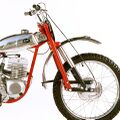Four bar linkages: Difference between revisions
No edit summary |
No edit summary |
||
| Line 13: | Line 13: | ||
==Virtual four bar linkage== | ==Virtual four bar linkage== | ||
<youtube>C8Za5GKdSUA</youtube> | <youtube>C8Za5GKdSUA</youtube> | ||
=Tools= | |||
<gallery> | |||
Wrench.png|link=[[Wrenches]]|[[Wrenches]] | |||
</gallery> | |||
=References= | =References= | ||
* [https://en.wikipedia.org/wiki/Four-bar_linkage Four bar linkage] | * [https://en.wikipedia.org/wiki/Four-bar_linkage Four bar linkage] | ||
* [https://en.wikipedia.org/wiki/Motorcycle_fork#Leading_link Motorcycle forks: leading link] | * [https://en.wikipedia.org/wiki/Motorcycle_fork#Leading_link Motorcycle forks: leading link] | ||
Revision as of 19:33, 26 March 2021
Introduction
A four-bar linkage, also called a four-bar, is the simplest movable closed-chain linkage. It consists of four bodies, called bars or links, connected in a loop by four joints. Generally, the joints are configured so the links move in parallel planes, and the assembly is called a planar four-bar linkage. Spherical and spatial four-bar linkages also exist and are used in practice.
Leading link suspensions
A leading link fork suspends the wheel on a link (or links) with a pivot point aft of the wheel axle. Russian Ural motorcycles used leading link forks on sidecar equipped motorcycles, and aftermarket leading link forks are often installed today on motorcycles when they are outfitted with sidecars. They are also very popular with trikes, improving the handling while steering or braking. The most common example of a leading link fork is that found on the Honda Super Cub.
Virtual four bar linkage


